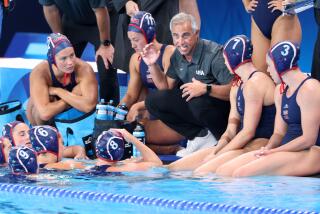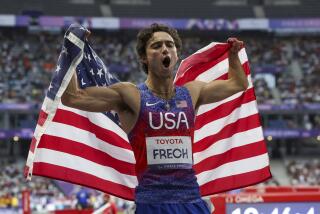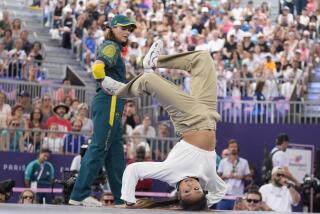Olympic Prospects Get Jobs at Firms in Orange County
James Bergeson’s water-polo playing sure doesn’t look like commercial lending. But as far as Security Pacific Bank’s personnel department is concerned, he’s doing exactly what he’s supposed to be doing.
At nearby Fluor, Greg Barton has a pretty strange job description for a mechanical engineer. It includes specifying machinery for processing plants, preparing requisitions to buy equipment and paddling down a lake.
Bergeson--a 1984 Olympic silver medalist--and Barton--considered a good candidate to win a gold medal this year in kayaking--are among 120 competing athletes who have received full-time jobs through the U.S. Olympic Committee’s Job Opportunities Program.
The national program is designed to solve a problem that has existed since the days of Ben Hur: How does a world-class amateur athlete get paid?
Earn While Training
While it’s not exactly the Soviet army, the program does allow American athletes to earn money while they train for the 1988 Games in Seoul, South Korea.
It works by allowing potential Olympians to be employed part time at full-time pay while they gain experience in a potential career field. Participants work in jobs with flexible schedules that give them time off to train and compete.
In Orange County this year, six companies have hired one athlete each. Across California, more than 30 athletes are participating in the program.
And the USOC has even bigger plans. Under a major expansion of the program to be announced soon, Orange County will
become one of three or four areas in the United States singled out to develop job opportunities for athletes.
The USOC envisions an increasing number of athletes from across the country moving to Orange County so they can take advantage of the sunny climate to train for yachting, canoeing, kayaking, rowing, water polo, and track and field events.
“Orange County is a high priority for a lot of the sports federations,” said Geoffrey Yarema, national chairman for the program. And corporations here are viewed as a largely untapped source of jobs.
Firms that hire potential Olympians are getting more than employees who pump iron.
“There’s the satisfaction of having helped the Olympic movement. And maybe, through the process, we’ve acquired a fantastic employee,” said Jim Straw, a spokesman for Irvine-based Avco Financial Services, which hired a world-champion track and field star, John Sayre.
There’s also loads of potential publicity if the athletes win medals.
The program originated 12 years ago when Howard Miller, then president of Canteen of Chicago, was watching the 1976 Montreal Games.
During the final round of the wrestling competition, Miller was chatting with the roommate of one of the wrestlers in the ring. The roommate told of how he had supported the athlete for three years.
Started Program in ’77
Miller, now USOC treasurer, officially started the Job Opportunities Program in early 1977.
Since then, at least 150 corporations have employed about 375 athletes.
The program runs in four-year cycles, with most of the hiring done 18 months to two years before the Olympic Games.
And because every dollar counts to a struggling athlete, the demand for jobs is huge. Up to 400 athletes were accepted into the current program, which has placed 160 athletes since 1985.
Even so, the program has drawn some criticism for commercializing athletes and not always placing them in positions that will lead to long-term employment.
By and large, though, athletes see the program as a godsend.
“How could I support myself (and still compete) without this job? I’d have to work in a bar as a bouncer or something,” said August Wolf, a track and field athlete who was hired as a sales manager for Western Digital, an Irvine-based computer products firm.
An injury caused Wolf to place fifth in the Olympic trials last month, which means he won’t be traveling to Seoul, but he plans to keep training for future shot-put competitions--and to continue working on a flexible schedule at Western Digital’s Santa Clara office.
“Even if I become one of the best in the world--and get lots of money out of it--I’ll still keep working here because I enjoy it and I’m learning,” Wolf said.
“Training for this type of program is hard enough as it is,” said Bo Eastabrooks, a kayaker who signed on in January with Irvine-based Waste Management of North America. “I personally wanted to be able to come out of the Olympics with something to start from, rather than having to start life from scratch.”
Received Full Benefits
Eastabrooks wasn’t paid for time taken off from work, but he did get full benefits and lots of flexibility for time to practice. While he did not qualify at the Olympic trials in June, he plans to continue training and working as a staff engineer at Waste Management.
“It’s a great company, and I see a lot of opportunities for me to learn,” he said.
Wolf, Eastabrooks and other program participants were placed through a rigorous screening process that started about as soon as the 1984 Olympics ended. That was when USOC in Colorado Springs, Colo., began sorting through what became stacks of resumes from hopeful athletes throughout the country.
More than a fair share of those arrived from California, which is expected to supply about half of the U.S. team that will compete in the 1988 Games, which begin in mid-September.
Applications are shipped to the respective sports federations, which determine if the individual athletes are potential Olympic candidates. The resumes of those who make the cut are then forwarded to businesses willing to hire them under the program.
For the companies, that means agreeing to provide time off for training, with salaries and details individually negotiated by the athletes.
On the average, participating athletes work close to 30 hours a week, with anywhere from a week to six months off for training, according to a 1984 USOC study. For that, the study showed, they receive an average annual salary of $18,000.
The program aims to place applicants in jobs that come as close as possible to matching their career training and goals. Many are in management trainee programs, but the jobs vary widely, ranging from warehouse clerks to financial analysts.
Most Have Degrees
About 95% of the applicants enter the program with college degrees, said Sheryl L. Abbot, program manager.
USOC is careful to point out that the jobs are not free rides. In fact, more than one athlete has lost a program-sponsored job by not showing up for work. “They are paid for the job they’re working,” Abbot said.
Those companies that do not pay athletes for training time are encouraged to make it up in other ways.
For example, Fluor pays only for time actually logged by Greg Barton, the kayaker. But Fluor also has made separate donations to the Olympic Paddling Committee to help bolster the sport.
Should an athlete start to slip and no longer qualify as an Olympic contender, his or her job status becomes the same as any other company employee.
To look at the numbers, the program has been a moderate success. Of 135 athletes placed between 1981 and 1984, 38 are still working for the same employers.
Anheuser Busch--by far the largest employer in the program--still employs one of the 24 Olympic hopefuls hired before the 1984 Los Angeles Games. But the St. Louis-based brewery was rewarded with a slew of medals that year--and placed a full-page ad in USA Today to show off its 12 employees who made the U.S. team.
And the program sure beats some of the alternatives.
Searching for Change
Sayre, Avco’s mechanical draftsman and the 1985 national decathlon champion, remembers how, as a college athlete, he and a roommate waded in a fountain, picking out change because they were broke.
“It’s the plight of the U.S. athlete,” he said.
Barton, Flour’s kayaker, used to make and sell canoe paddles for a living.
Since being hired by Fluor, Barton said, he has been able to train for 1 1/2 hours in the morning before starting work at 9 a.m. He typically ends the work day at 3:45 p.m., then heads to Newport Beach’s Back Bay to train for another 1 1/2 hours.
Barton earned about $15,000 last year at Flour. That was for working about half-time and taking three to four months off for competitions. These days, he is in Lake Placid, N.Y., training for the trip to Seoul.
“It’s a steady job, and I know that after the Olympics is over, I’ll have a good start,” he said.
Training for a career isn’t the only benefit.
“It gets harder as we get older--half the team is married,” said Kevin Robertson of Costa Mesa, a 1984 silver medalist who is now competing in a water-polo tournament with the U.S. team in Duisburg, West Germany.
Robertson worked as a loan representative for First Interstate until about six months ago, when “we basically put our lives and our careers on hold. You have to make that final sacrifice--or you’re kidding yourself if you think you’re going to win a gold medal.”
The program doesn’t only help the athletes. In many cases, employers gain disciplined workers who may sign on permanently.
“Companies are getting someone with certain work qualities and ethics that carry over from the sport to the job,” said James Bergeson, a 1984 silver medalist who is now competing with the U.S. team in Duisburg.
Gives Company Pride
Bergeson was hired under the program by the real estate industries group of Security Pacific Bank in Irvine. It’s something, he said, that also gives the company “a certain amount of pride.”
Although the Jobs Opportunity Program is valuable for some, it doesn’t meet the needs of every athlete.
Some athletes complain of being hired for one job and ending up doing another or, even worse, not much of anything--which isn’t the idea.
“If companies don’t intend to put athletes in career-oriented positions, they’re probably better off donating the money and supporting the Olympics that way,” said one athlete who asked not to be named.
But even with its flaws, the program provides a way for amateur athletes to nurse their financial wounds.
After all, “if you just go for the Olympics, you’re going to starve to death,” Sayre said. “In this country, if you don’t work you don’t eat--no matter how good you are.”
More to Read
Go beyond the scoreboard
Get the latest on L.A.'s teams in the daily Sports Report newsletter.
You may occasionally receive promotional content from the Los Angeles Times.






